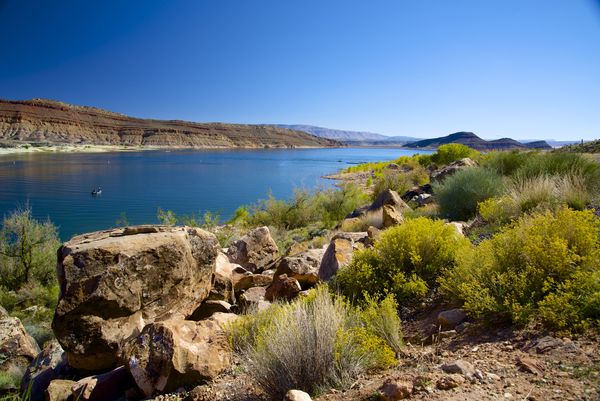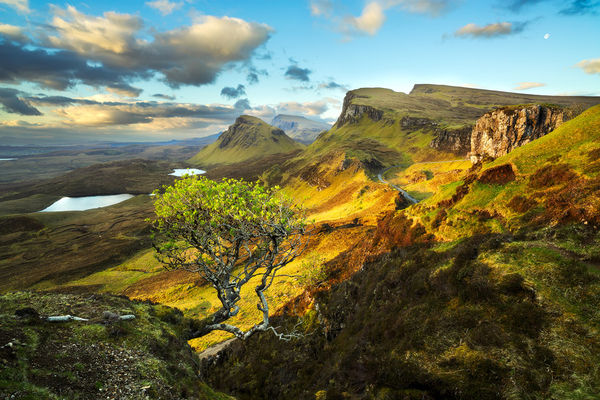Check out Sports Photography section of our forum.
Question about CP filter
Nov 17, 2013 17:58:04 #
My question is about the sky being darker on the left than on the right.
Photo info
Camera D600
Lens 24-85 kit
Iso 100
F/8
1/60
I took this in southern Utah about 12:30 PM with the sun just on my left just behind my shoulder .
Is this darkening a result of the suns position in the sky or was it because I had not turned the filter enough? I just got this filter and its my first time using one on a digital camera.
Photo info
Camera D600
Lens 24-85 kit
Iso 100
F/8
1/60
I took this in southern Utah about 12:30 PM with the sun just on my left just behind my shoulder .
Is this darkening a result of the suns position in the sky or was it because I had not turned the filter enough? I just got this filter and its my first time using one on a digital camera.

Nov 17, 2013 18:05:17 #
A CPL filter will darken everything uniformly - the main purpose of it is to cut glare. If you want to darken just the sky then a graduated ND filter is needed or you can do it in post-processing.
Nov 17, 2013 19:30:02 #
A Circular Polarizing Filter (not lens) is strongest, and uniform, when camera lens is facing 90-degrees from sun. If the sun is directly behind you, it is least effective on sky. Effect becomes more prominent as you angle camera towards perpendicular to sun.
Wide-angle lenses exaggerate the polarizing difference to sky, as one side of image is a different angle from sun, compared to opposite side. The wider the angle, the more difference in sky color, side to side.
Wide-angle lenses exaggerate the polarizing difference to sky, as one side of image is a different angle from sun, compared to opposite side. The wider the angle, the more difference in sky color, side to side.
Check out Landscape Photography section of our forum.
Nov 17, 2013 19:41:15 #
Thank you Nikonian that helps. I took a few other shots with the same lens and the sun was behind me in those shots the sky color was even. So I will keep this in mind when using this lens and the filter.
Nov 17, 2013 20:09:49 #
I have had this happen, as well.
I need to slow down and recognize what is happening. Maybe better to not use the filter in this situation or lighten up the effect (not apply the effect as much).
Pat
I need to slow down and recognize what is happening. Maybe better to not use the filter in this situation or lighten up the effect (not apply the effect as much).
Pat
Nov 18, 2013 08:09:30 #
Ruthiel wrote:
My question is about the sky being darker on the left than on the right.
Photo info
Camera D600
Lens 24-85 kit
Iso 100
F/8
1/60
I took this in southern Utah about 12:30 PM with the sun just on my left just behind my shoulder .
Is this darkening a result of the suns position in the sky or was it because I had not turned the filter enough? I just got this filter and its my first time using one on a digital camera.
Photo info
Camera D600
Lens 24-85 kit
Iso 100
F/8
1/60
I took this in southern Utah about 12:30 PM with the sun just on my left just behind my shoulder .
Is this darkening a result of the suns position in the sky or was it because I had not turned the filter enough? I just got this filter and its my first time using one on a digital camera.
Nov 18, 2013 08:11:07 #
Check out Infrared Photography section of our forum.
Nov 18, 2013 09:15:56 #
if you were shooting at the widest mm you can get uneven polarizing effects in the sky. There is also a little vignetting in the RU corner
Nov 18, 2013 13:13:08 #
Look at live view as you turn the CP to get evenness in the sky. 90 degrees from the sun might be the best location, but you can use CP's in other lighting situations also. You just need to be careful and patience (no snapshots) to get what you want.
Nov 18, 2013 13:23:22 #
Ruthiel wrote:
My question is about the sky being darker on the left than on the right.
Photo info
Camera D600
Lens 24-85 kit
Iso 100
F/8
1/60
I took this in southern Utah about 12:30 PM with the sun just on my left just behind my shoulder .
Is this darkening a result of the suns position in the sky or was it because I had not turned the filter enough? I just got this filter and its my first time using one on a digital camera.
Photo info
Camera D600
Lens 24-85 kit
Iso 100
F/8
1/60
I took this in southern Utah about 12:30 PM with the sun just on my left just behind my shoulder .
Is this darkening a result of the suns position in the sky or was it because I had not turned the filter enough? I just got this filter and its my first time using one on a digital camera.
Ruthiel,
Based on the image you included and your question, what you see is a result of having a Circular Polarizer Filter (CPL) attached to your lens. The most effective range of the filter is 90 degrees to the sun, as you can see in the left corner of the sky.
The CPL, as you noted, can be turned for adjustment and effectiveness. It looks like you did not adjust the filter while viewing the scene through the viewfinder. By adjusting the filter for effect you can balance the effectiveness in the sky to obtain a more uniform darkening of the sky. (This depends on the focal length of the lens, the shorter the focal length (near 35mm) the less you can balance the effect.) By adjusting the filter you can degrease the water reflections, and if you can use a longer focal length lens you can adjust the filter to give a proper balance to the sky, and remove some water reflections.
If you cannot use a longer focal length lens then remove the CPL filter, it is causing shadows on the lens in the corners (vignetting).
Keep in mind, with digital you have Post Processing tools that can simulate Polarizer Filters to some degree.
Michael G
Nov 19, 2013 18:17:25 #
TheDman
Loc: USA
I don't even use mine to enhance skies anymore for this reason. I think it's more effective at removing glare from water and enhancing foliage.
Nov 19, 2013 18:48:40 #
TheDman wrote:
I don't even use mine to enhance skies anymore for this reason. I think it's more effective at removing glare from water and enhancing foliage.
If you can utilize a filter on the lens it can be much more effective than anything in PP. With the CPL on the lens you don't have to worry about the division between sky and horizon, you can allow the CPL filter to blend the effects.
If you want to spend the majority of your time looking at your monitor and modifying your image in PP that is your choice. If you wan to spend, as much time as possible, in the field capturing good photographs, then the best option is to do as much correction as possible before the exposure.
Sometimes we must make creative decisions with our CPL filters, and decide we will later use PP to make more corrections. These could include ignoring the sky and concentrating on water reflections, display window reflections from the street, and glare from leaves.
The CPL filter is another tool we must learn to use, experiment with, and master its capabilities, to use in an intelligent creative manner.
The CPL filter is not an "end all tool", it works alongside other tools in our digital tool box.
Michael G
Nov 19, 2013 20:34:49 #
Thank you all for the information I really appreciate it. I will slow down and Pay attention to what I see in the viewfinder and where the sun is. I like the filter. Living where I do with bright sunlight about 300 days of the year and my personal attraction to water I will be using the filter often.
Nov 20, 2013 01:57:55 #
TheDman
Loc: USA
Armadillo wrote:
If you can utilize a filter on the lens it can be ... (show quote)
I don't consider photos with skies half too blue and half not blue enough to be good, though. To me CPLs don't 'correct' skies, they ruin them, especially on wide angles. Here is a recent shot that was 90 degrees to the sun. Skipped the CPL, and I think the division between sky and horizon is just fine. I think a CPL would have ruined it.

Nov 20, 2013 02:04:25 #
TheDman wrote:
I don't consider photos with skies half too blue and half not blue enough to be good, though. To me CPLs don't 'correct' skies, they ruin them, especially on wide angles. Here is a recent shot that was 90 degrees to the sun. Skipped the CPL, and I think the division between sky and horizon is just fine. I think a CPL would have ruined it.
TheDman,
You have a nice picture you attached.
You have some good points on the CPL filter, however it is a tool and needs to be used correctly, or at times removed. It's just a tool in your photo toolbox.
Michael G
If you want to reply, then register here. Registration is free and your account is created instantly, so you can post right away.
Check out Astronomical Photography Forum section of our forum.






